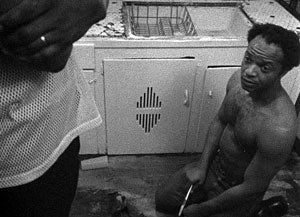Anyone following the L.A. Rebellion film series has probably noticed that the film term ‘neorealism’ comes up a lot in discussions of the films. It is no coincidence that the UCLA Film & Television Archive has been showing a program on Italian neorealism at the same time. Charles Burnett’s film Killer of Sheep (1977) is a prime example of the how closely these two film movements relate.
The key elements of Italian neorealism included filming on location, using nonprofessional actors, and narratives that focused on the hardships of everyday working class life in post-World War II Italy. One of the best-known films of the neorealist movement is Bicycle Thieves (1948) by Vittorio De Sica—it is also relates to Killer of Sheep. Both films focus on family men trying to support their families with limited means. Killer of Sheep is filmed on location in Watts, following the “riots” that occurred in 1965—an environment that resembles that of post-WWII Italy we see in the Bicycle Thieves; Paula J. Massood touches on this when she describes Watts as “resembl[ing] a war zone, with empty lots and abandoned buildings dotting the urbanscape.” [1]

There are many differences too, mainly in that Killer of Sheep focuses so much on the characters’ everyday lives that it seems more like a documentary than a fiction film. Bicycle Thieves has a clear plot: Antonio, the main character, has his bicycle stolen and he spends the entire film trying to find it. In Killer of Sheep, the main character Stan and his friend buy a motor for a car and then it is promptly destroyed, reminiscent of Antonio’s bike being stolen. Both the motor and the bike are symbols of freedom, tools that would improve their lives. But while the search for the bike occupies the majority of Bicycle Thieves, in Killer of Sheep, Stan never repairs the motor and just moves on to the next, usually equally fruitless moment. The motor is just one of many defeating episodes he encounters in his daily life.
Themes of defeat and despair link Killer of Sheep with its spiritual prequel Several Friends (1969). In Several Friends, three men excitedly make plans to go up to Hollywood and meet women, but when the most responsible of the three comes to pick up the other two, he finds them absorbed with the activity of clumsily moving a washing machine through the house. By the time the men have completed the task, they are sweaty and tired and clearly will not be making it to Hollywood that night – the three end up sitting around the kitchen table drinking Boone’s Farm and vaguely lamenting the fact that they never seem to make it to these events they plan to attend.

In a related sequence, Killer of Sheep portrays Stan’s protracted attempts to get a new engine in order to get his car running. It’s a lengthy process in which he must find the extra money, enter an unfamiliar environment and buy the engine from a group of people engaged in a very strange argument, and lug the heavy piece of machinery down a flight of stairs and into the bed of a truck. Though Stan is concerned the engine might fall off the back of the truck, his exhausted friend Bracy convinces him not to worry; predictably, as soon as the two start the truck and begin to drive up the steep street, the engine falls to the pavement and breaks. Stan’s disappointment is palpable as they leave what is now scrap metal in the street and drive away.
“Disappointment” isn’t really the right word, though—it’s more of a combination of resignation and quiet despair, a mood which at least partly defines the tone of both Several Friends and Killer of Sheep. In both films (and in terms of Killer of Sheep, specifically the engine episode), the characters are entangled in a system of non-progress. They aspire to improve their social position by making themselves mobile and moving out of their unsatisfying conditions (both literally and metaphorically), but ultimately their plans are frustrated at every turn. What’s worst is that the obstacles are so trivial: Stan and Bracy are simply careless with the engine, the characters in Several Friends fail to plan their time well, and then one hasn’t showered, then they all start drinking—none of these are large catastrophes or surprising turns in the narrative. They are simply low-level frustrations and obstacles of daily life that combine to slowly pull down a person’s soul.
Also a constant source of frustration in both films is the tension within the marriages of the main characters. Stan seems to lack intimacy and respect from his wife in Several Friends. Bracy in Killer of Sheep creates distance between himself and his wife either due to humiliation around the stagnation in his life or because disconnection has become a survival mechanism for him. Either way, in both films the marital woes, day-to-day immobility and personal challenges serve to represent men who virtually are stuck, prisoners inside their own lives with not a clue on how to escape. The films never directly blame anyone or anything for such inaction. Viewers are left to interpret for themselves whether the men are at fault, or whether their troubles are a result of systematic racial oppression or inequality. However, the films do hint to racial issues as a barrier in Burnett’s character’s lives. As with Pierce’s seeming aimlessness in My Brother’s Wedding, the feeling that progress through life or in social situation is simply impossible very much arises from a system that itself makes such progress so difficult. Especially for African American viewers of the time, overtly remarking on systematic racism’s contribution to this problem would be unnecessary, a totally superfluous explanation of a world that viewers already understand well.
- Jessica Hokanson, Bryan Wuest, Felischa Marye, Karrmen Crey
[1] Paula J. Massood, “Appropriate to Conditions: Killer of Sheep, (Neo)Realism, and the Documentary Impulse,” Wide Angle, 21.4 (October 1999): 36.






 Mobile Navigation
Mobile Navigation

